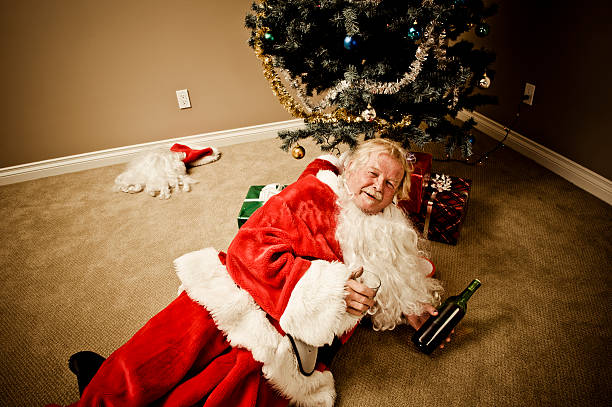As the holiday season approaches, the character of Santa Claus emerges in various forms, his iconic red suit and white beard eliciting warmth and joy in the hearts of children and adults alike. However, amid the cheerful carols and festive decorations, a curious rumor has begun to circulate: “Santa Claus is ugly.” While this statement may seem incongruous to the well-loved image of Santa, it raises a thought-provoking question about the nature of popular symbols, cultural narratives, and the power of perception.

The Origins of Santa Claus: A Brief Overview
To understand the roots of the conversation surrounding Santa’s appearance, it is essential to explore the historical and cultural origins of St. Nicholas, the man behind the myth. St. Nicholas was a 4th-century Greek bishop known for his generous deeds, particularly towards children and the less fortunate. His legacy evolved through centuries and across cultures, leading to the conception of Santa Claus that we recognize today—a figure embodying the spirit of giving and joy.
Over centuries, the image of Santa has been influenced by a plethora of cultures and artistic representations. From the Dutch “Sinterklaas” to the jolly depiction popularized by 19th-century artists like Thomas Nast and later commercialized by companies like Coca-Cola, Santa’s portrayal has played a significant role in shaping public perception. This transformation reflects society’s evolving ideas about kindness, generosity, and, inherently, beauty.
The Emergence of the ‘Ugly Santa’ Narrative
The notion of “Santa Claus is ugly” appears to be an unconventional twist on the traditional depiction of this beloved holiday figure. At first glance, it might seem a stretch to label Santa as ugly, but this characterization can be interpreted through various lenses, including realism, cultural critique, and even self-reflection.
Realism and the Flaws of Humanity: One could argue that Santa, as a character, embodies the imperfections of real life. The spirit of Santa is not one of pristine perfection but of heart, generosity, and the ability to embrace the flawed aspects of humanity. This perspective posits that if Santa were a reflection of the average person—perhaps with an unkempt beard, misfit attire, or a plump physique—he would fit the description of being “ugly” in a superficial sense. This interpretation challenges society’s narrow definitions of beauty and encourages deeper consideration of what is truly important during the holiday season.
Cultural Critique and Consumerism: Additionally, labeling Santa as ugly can be viewed as a form of social commentary. In an age where consumerism often overshadows the true essence of the holidays, this characterization offers a critique of the idealized images that marketing perpetuates. The question arises: do we care more about the image of Santa as a perfect, shiny figure, or do we resonate more deeply with a raw and authentic portrayal—one that brings to light the hardship and beauty found within the human experience? The narrative of “ugly Santa” can serve as a call to recognize the inherent value in simplicity, honesty, and a return to the core values of compassion and goodwill.
Self-Reflection and Personal Experience: Finally, the narrative may have roots in personal reflections on identity, especially during the holiday season—a time when many experience feelings of inadequacy. The metaphor of Santa as “ugly” can resonate with individuals who struggle with their sense of self-worth, particularly during a period characterized by high expectations for joy and togetherness. Recognizing that even Santa, the epitome of holiday cheer, can be seen as “ugly” in a societal context, can be a powerful reminder that beauty is subjective and that feelings of inadequacy are universally experienced.
Reclaiming Santa’s Image: Embracing Diversity and Authenticity
In recent years, the holiday narrative has expanded to embrace a broader range of representations of Santa Claus. We see an increasing variety of Santas across cultures, ethnicities, and physical appearances, reflecting the diverse population of our world. This shift towards inclusivity encourages a more profound appreciation for the spirit of the season rather than a superficial reflection on physical appearance.
Moreover, this broadening representation fosters conversations about acceptance and encourages children and adults alike to celebrate differences. The essence of Santa—his kindness, generosity, laughter, and ability to bring people together—remains far more important than his physicality.
As we navigate through the holiday season, we encounter countless interpretations and representations of Santa Claus. The rumor that “Santa Claus is ugly” serves as an exploration of deeper societal issues, challenging us to reconsider our definitions of beauty, authenticity, and self-worth. While Santa’s image may have its flaws, it is his spirit and legacy that continue to instill joy, warmth, and kindness across generations.
So perhaps it is time to reframe the conversation. Let us instead celebrate the multifaceted nature of Santa Claus—a symbol not only of holiday cheer but of the acceptance of our varied human experiences. In doing so, we not only embrace the character of Santa Claus but also honor the more profound message he embodies: that the spirit of giving, love, and joy is truly what makes the holiday season beautiful, regardless of how one may appear on the outside.


Related post
The Most Heartwarming Moments of Spider Man On Screen
The world of Spider-Man is not just filled with thrilling battles and breathtaking stunts; it’s a tapestry woven with moments of profound empathy, love, and
10 Unusual Christmas Traditions Around the World You May Not Know About
Christmas, a time for festive cheer, family gatherings, and the exchange of gifts, is celebrated globally, but the traditions associated with it vary wildly across
5 Tips to Style Hoodies on Cold Winter Days
As winter settles in, many of us find ourselves reaching for cozy essentials that provide warmth and comfort. One such wardrobe staple is the hoodie.
Guide to Creating a Heavy Metal Sound in the Style of Tony Iommi
Heavy metal is a genre rich with history and technical prowess, and few guitarists have influenced its sound as profoundly as Tony Iommi, the legendary
Breaking Down the Key Tactical Edgeas in the Oakland Raiders Lineup
Breaking Down the Key Tactical Edges in the Oakland Raiders’ Lineup reveals not just a football team but a storied franchise with an indomitable spirit.
The Most Heartwarming Moments of Spider Man On Screen
The world of Spider-Man is not just filled with thrilling battles and breathtaking stunts; it’s a tapestry woven with moments of profound empathy, love, and
10 Unusual Christmas Traditions Around the World You May Not Know About
Christmas, a time for festive cheer, family gatherings, and the exchange of gifts, is celebrated globally, but the traditions associated with it vary wildly across
5 Tips to Style Hoodies on Cold Winter Days
As winter settles in, many of us find ourselves reaching for cozy essentials that provide warmth and comfort. One such wardrobe staple is the hoodie.
Guide to Creating a Heavy Metal Sound in the Style of Tony Iommi
Heavy metal is a genre rich with history and technical prowess, and few guitarists have influenced its sound as profoundly as Tony Iommi, the legendary